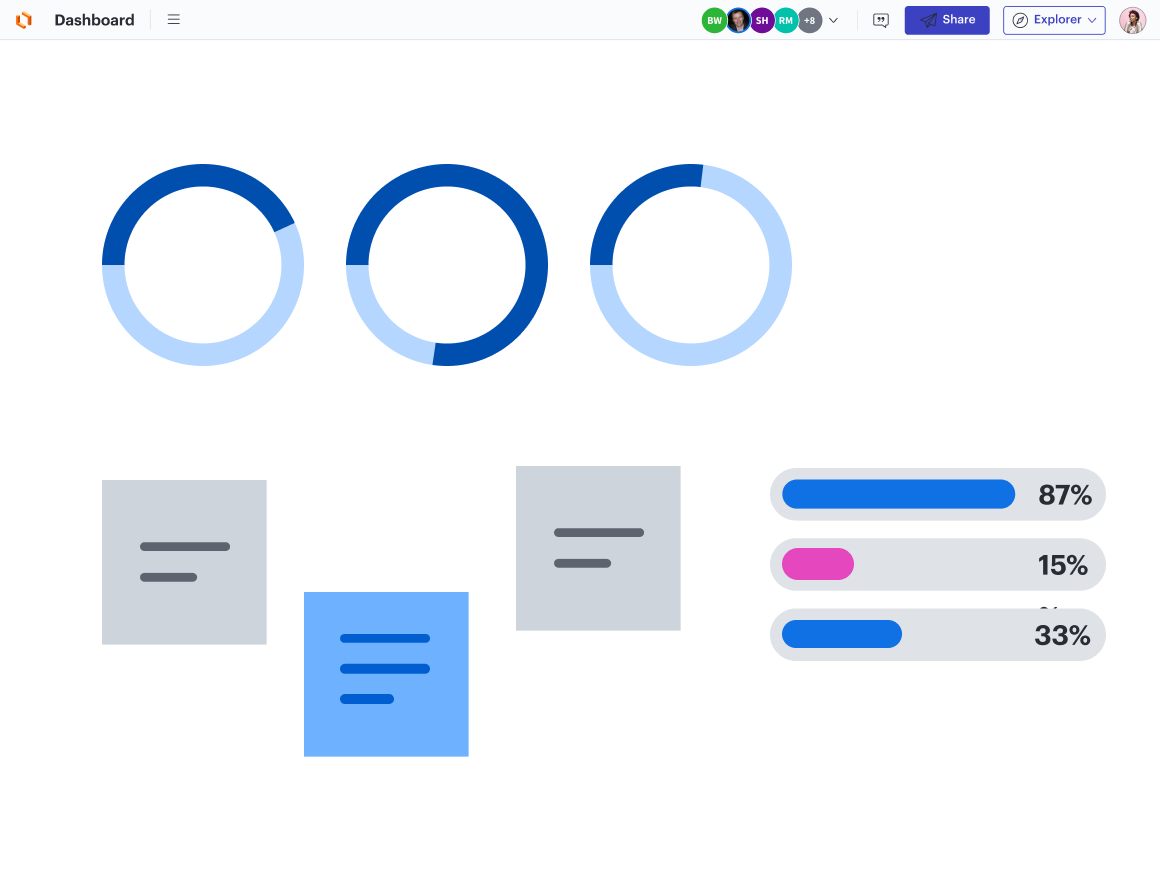
A step-by-step strategic planning guide
Reading time: about 13 min
Imagine you’re standing at the base of a mountain. At the top is the business of your dreams: Everything runs smoothly, customers are flooding in, and team members are motivated. To get there, you need to know how to navigate the treacherous terrain in front of you.
That’s where a strategic plan comes in.
An effective strategic plan needs to be a detailed roadmap. It should answer three crucial questions: Where are we now? Where are we going? How do we get there?
Creating such a document is easier said than done, especially when most of the resources you’ll find on the subject lack the gritty how-tos you need to succeed.
That’s why we created this strategic planning guide—to provide a hands-on, step-by-step walkthrough (with templates) for creating a detailed and effective document that acts as a GPS for your teams. So, let’s go beyond theory and start creating your ideal strategic plan.
Before you begin: Choosing a platform
Before diving into the creation of your strategic plan, you’ll need to decide on a platform to host it. Our preferred method is to use a visual collaboration platform to create your document.
Visuals make information digestible, clear, and actionable. When teams create visual strategic plans, they can easily communicate with collaborators, stakeholders, and other external contributors. All they need to do is add a sticky note directly on the portion of the plan where they’re confused or need to ask a question.
Visual strategy documents also display critical connections and relationships within your strategic plan. Through that foresight, you can more easily see the impact of your decisions early.
When picking a visual platform to host your strategic plan, you’ll want to be sure it:
- Integrates well with critical applications in your tech stack.
- Leverages data and automation to stay accurate.
- Is cloud-based and accessible from anywhere (meaning remote and hybrid teams can collaborate as well).
Pro tip: The Lucid Visual Collaboration Suite includes virtual whiteboarding and intelligent diagramming and allows teams to work on an infinite canvas to show all the context of your strategic plan in a centralized location. This visibility allows you to see the impact of your decisions quickly.
5 steps to creating an effective strategic plan
It’s important to highlight that while this is a step-by-step guide to strategic planning, you have to think intentionally and, well, strategically about strategic planning. As they say, make sure you know the rules so you know how to break them.
To start, we’ve created a strategic planning template specifically set up to guide you through this process. As you go through this post, you can begin outlining and working through the template right alongside us.

Inside, you’ll find a list of the different components your strategic plan can include and explanations for each. This way, you can decide which elements are critical to your unique plan and adapt the template accordingly.

Step 1: Determine your current strategic position
Assessing your current position creates the foundation for the rest of the planning process. By identifying strengths, weaknesses, opportunities, and threats, you can inform your decisions as you move forward.
Here are the four methods you should implement to determine your current strategic position:
Method 1: Host stakeholder interviews to gather insights from the people directly or indirectly affected by your organization's operations. This includes customers, employees, suppliers, and partners.
Method 2: Conduct a PESTEL or SWOT analysis. These structured frameworks provide a systematic way to analyze both external and internal factors that can impact your organization.
- PESTEL analysis: Focuses on political, economic, social, technological, environmental, and legal factors affecting your organization. This analysis helps you understand the broader market and regulatory context.
- SWOT analysis: Examines your organization's strengths, weaknesses, opportunities, and threats. It's an internal and external analysis that helps identify areas for improvement and areas where you have a competitive advantage.
Method 3: Create an inventory of all your resources, categorizing them by type (human resources, financial resources, technology, and physical assets). This inventory can include a breakdown of your teams' roles and organizational positions. An organizational chart can be particularly useful in visualizing your team's structure.

Method 4: Last but certainly not least, you’ll want to engage with traditional benchmarking to measure both internal metrics (by looking at dashboards and data) and industry benchmarks. This step may involve pulling a simple report or diving deeper into the weeds with your existing reporting methods to track both past and present performance.
Once you've gathered information through these methods, the next step is to analyze and synthesize the data. Look for patterns, trends, and common themes.
Based on your analysis, you can identify areas that require attention, such as improving internal processes, capitalizing on market opportunities, addressing customer concerns, or mitigating potential threats.
Step 2: Set goals, determine the vision, and outline your plan
Now we’ll see the strategic planning process kick into gear. Our aim for this next phase is to set clear goals and define your vision. There are three critical components to this step: a vision statement, a mission statement, and key performance indicators (KPIs).
Vision statement
Your vision statement paints a picture of what your company aspires to become in the future, and most importantly, why you’re aiming for that future vision. Having a solid “why” and being able to make that clear to employees, stakeholders, and customers is the key to laying a strong strategic foundation.
Crafting a compelling vision statement is not just a task for the leadership team; it should engage every team member. The best way to involve your entire team? Lucid’s Visual Activities.

Key performance indicators (KPIs)
Incorporating KPIs into your strategic plan is crucial. Non-negotiable. They not only help your team visualize milestones but also provide objective numbers to gauge your progress. KPIs take your strategy to the next level by making it actionable and results-oriented.
To determine the right KPIs for your organization, you can start by asking two simple questions:
- How will we know we’re successful (i.e., what is success to us)?
- What methods will we use to measure that success?
You’ll want to list out your KPIs throughout your entire strategic plan. Put these metrics on your timelines, project plans, goal pages, process docs, and more throughout the broader strategy. KPIs are the key to making your plan data-driven.
This step is all about setting the direction, purpose, and metrics for success. It's about envisioning the future and equipping your organization with the tools and targets to achieve its goals.
Time to start climbing that mountain.
Step 3: Determine how you'll achieve your goals
Now, you’re going to determine what actionable steps are needed to translate vision into strategy, including who is doing what and by when.
Establishing OKRs (objectives and key results)
OKRs are a powerful tool for goal-setting and alignment. They help teams understand what they’re working toward, how to measure progress, and how to set realistic milestones.
Think of it this way: You can find your KPIs at the top of the mountain—they’re your markers for success and as such, you’ll be measuring them throughout the life of your vision. OKRs act as signposts on your way up the mountain, functioning as guiding markers to let you know if you’re hitting the right milestones to achieve the end result (as defined by the KPIs).
Incorporating OKRs into your strategic plan ensures that your entire organization is on the same page, working towards common objectives.
Once you’ve determined your OKRs, you’ll want to incorporate them into your strategic plan. Depending on the subjective structure of your strategy document, you’ll likely want to give your OKRs their own section to make them persistently visible to your teams.
Mapping your strategic goals and timelines
To help your team and stakeholders understand the big picture and how individual components are interconnected, try mapping your strategic goals. Creating this visual diagram will mean that instead of listing your goals, or perhaps in conjunction with a list, you can show your teams a visual map of your goals and how different elements impact each other.
The implementation phase of strategic planning is often challenging. Clear timelines ensure that everyone understands the schedule and what they’re responsible for so they can coordinate their efforts effectively.
Taking inventory of resources and developing a people strategy
To execute your strategic plan, you need to understand your available resources. Taking inventory of your resources involves identifying what you have in abundance and what you still need to reach your goals. In this case, we’re specifically talking about the people in your organization and how best to allocate their time, talents, and responsibilities.
First, you’ll want to try creating an organizational chart to help you understand the structure of your organization, roles, and reporting lines.
Here are some additional steps to consider:
- Skills assessment: Review the skills and competencies needed to achieve your strategic goals. Identify any skill gaps that need to be addressed through training or hiring.
- Structure review: Evaluate your organizational structure to determine if it supports your strategic objectives. Consider if any adjustments or reorganizations are necessary.
- Talent development: Develop a plan for talent development and succession to ensure a continuous pipeline of skilled employees.
By creating a clear action plan, establishing OKRs, visualizing your strategy, setting timelines, and assessing your resources and talent, you pave the way for successful execution. Remember that strategic planning is an ongoing process, so regularly review and adapt your plan as circumstances evolve.
Step 4: Implement your plan
Congratulations! You’ve got all the essential components of a stellar strategic plan. Now comes the pivotal phase of putting your plan into action. Implementation is where strategy meets reality, so let’s ensure your vision materializes effectively.
Change management
Change is always difficult, especially when convincing an entire organization to get on board with your strategic plan. This is the area where most leaders struggle with strategic planning. Even if you manage to create the document, cover all the topics, and develop strategies to execute, if you can’t get your teams on board, it’s all for nothing.
This is where exceptional leadership comes in. When executives and senior leaders act as primary sponsors of the strategic plan, it’s much easier to successfully drive implementation.
To do so, many leaders employ change management frameworks and techniques. There are several different options (including Kotter’s eight-step change model, McKinsey’s 7s model, ADKAR, and more) to choose from.
The role of visualization in gaining team buy-in
Visibility and transparency is the name of the game when it comes to getting your teams aligned with your strategies. This is where the power of visual collaboration really shines because when your strategic planning document is visual, it makes it that much easier for everyone to understand where the organization is heading.
Lucid’s visual collaboration platform allows companies to create a single source of truth, which means all the documentation we’re discussing in this guide (and beyond) can live in a centralized location. This eliminates the need for teams to go searching for information or to be in the dark about the overall strategic direction.
With Lucid, you’re actively encouraging visibility and transparency, increasing the likelihood of successfully implementing your strategic plan.
Additionally, it’s especially important to remain open and agile in this process. You may get halfway up the mountain before you realize there’s a massive river blocking your path, and you need to adjust your plan to go around it. Or, you may have been heading east when really you should’ve been going west. Staying open and aware of any necessary changes is critical.
Step 5: Monitor progress toward goals
One of the most common mistakes that’s all too easy to make is implementing your plan and forgetting to follow up on how it’s moving the needle. Monitoring your progress ensures your organization stays on track, adapts to changing circumstances, and ultimately achieves its objectives.
Ensuring team consensus and project closure
After a project or phase is completed, conduct a retrospective to assess what went well, what could be improved, and what lessons were learned. This process is essential to encourage and create a culture of continuous improvement.
Gathering regular feedback
To gather feedback, employ a multifaceted approach that encompasses both internal and external perspectives. That might include sending out surveys, conducting interviews, organizing focus groups, or even hosting workshops or retreats. Essentially, your goal is to gather feedback from both your teams and your customers as often as you reasonably can.
The most important thing is to foster an open and inclusive environment for this process. That process is essential for collecting honest, diverse, and constructive feedback. When team members feel safe to voice their opinions, you can uncover valuable insights.
To create an open environment for feedback, make sure:
- Leaders actively encourage and appreciate feedback.
- All voices are heard, regardless of rank or position.
- Feedback is treated as an opportunity for improvement, not criticism.
The other type of feedback you’ll want to gather is operational feedback. Operational feedback focuses on the effectiveness of your processes, systems, and data management. It helps you identify bottlenecks, inefficiencies, or areas needing improvement.
Methods for gathering operational feedback include:
- Dashboards
- Reports
- Audits
- Evaluations
Pro tip: Lucid’s data linking feature can make visualizing operational data a breeze.

Continuous iteration
Monitoring progress is not a one-time event; it's an ongoing process. Feedback should be collected at regular intervals, typically quarterly or annually, depending on the pace of your industry and the nature of your strategic initiatives.
As you gather feedback, be prepared to iterate and revise your plan based on the insights obtained. This iterative approach ensures that your strategic plan remains dynamic, adaptive, and aligned with your organization's evolving goals and external environment.
Incorporating feedback as an integral part of your strategic planning process fosters a culture of continuous improvement. It empowers your organization to make data-driven decisions, respond to challenges proactively, and ultimately achieve long-term success.

Visualize your strategic plan in Lucid
Investing in a visual collaboration platform takes your plan from paper to practice. It's the difference between wishing for success and actually aligning your team and resources to make it happen. Visuals transcend all confusion regarding the complex nature of a strategic plan, and with everything in one centralized location, your team can access, update, and collaborate effortlessly.
And the real beauty of visual documents? They're agile. You can iterate, adapt, and evolve in real-time.
The Lucid Suite includes Lucidspark, our virtual whiteboarding tool, and Lucidchart, our intelligent diagramming solution. With these two powerful applications, you can design a strategic plan that will guide your organization up that mountain and help you reach your vision of success.

Ready to start creating your strategic plan? Reach out to us today and let’s get started.
Request a demoAbout Lucid
Lucid Software is a pioneer and leader in visual collaboration dedicated to helping teams build the future. With its products—Lucidchart, Lucidspark, and Lucidscale—teams are supported from ideation to execution and are empowered to align around a shared vision, clarify complexity, and collaborate visually, no matter where they are. Lucid is proud to serve top businesses around the world, including customers such as Google, GE, and NBC Universal, and 99% of the Fortune 500. Lucid partners with industry leaders, including Google, Atlassian, and Microsoft. Since its founding, Lucid has received numerous awards for its products, business, and workplace culture. For more information, visit lucid.co.





